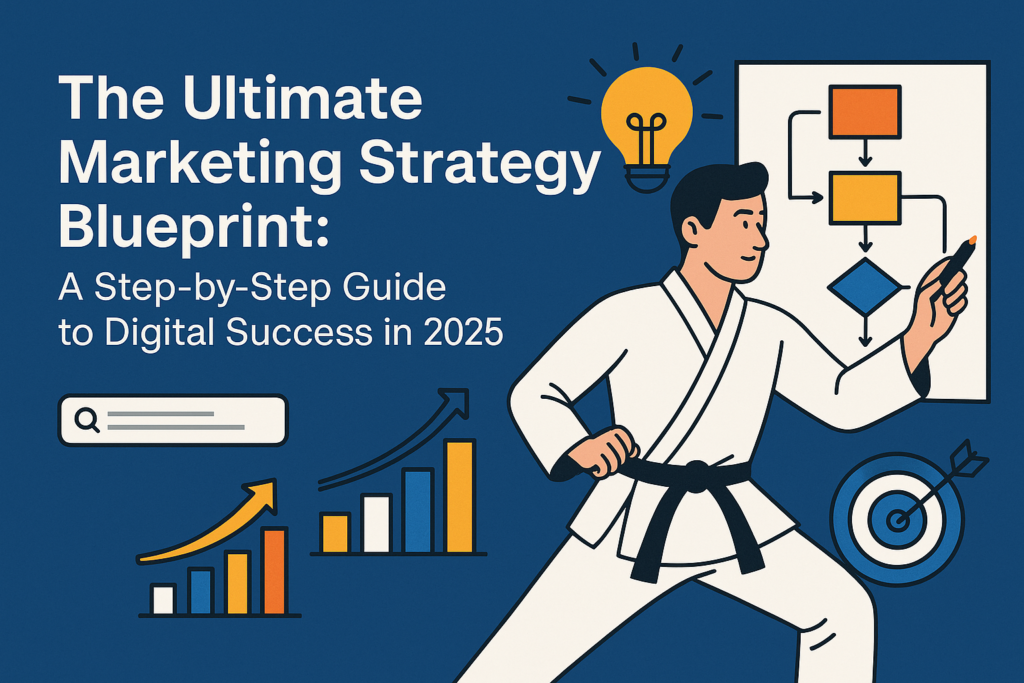In today’s hyper-digital world, businesses are constantly vying for attention. With so much noise online, how do you ensure that your brand stands out and reaches the right audience?
The answer lies in having a strong marketing strategy—a clear, customized plan that aligns with your business goals and audience behavior. Whether you’re running a personal brand, an e-commerce store, or a digital agency, your marketing strategy acts as the roadmap to long-term growth and visibility.
In this blog, we’ll explore the ultimate marketing strategy blueprint that helps you grow your brand, connect with your audience, and achieve real, sustainable digital success.
What is a Marketing Strategy?
At its core, a marketing strategy is a carefully structured plan that outlines how a business will reach its target audience and convert them into customers. It’s not just about running ads or posting on social media; it’s about creating a long-term vision that guides every piece of content, every campaign, and every customer interaction.
A good marketing strategy focuses on:
- Understanding customer behavior
- Setting clear goals
- Choosing the right channels
- Building a consistent brand voice
- Measuring results and improving continuously
Why is a Strong Marketing Strategy So Important?
Without a clear marketing strategy, even the best products or services can get lost in the noise. Here’s why strategy is non-negotiable in digital marketing:
1. Provides Direction
A strategy gives your marketing efforts purpose. Instead of randomly posting or emailing, every action has intent and direction.
2. Saves Time and Resources
You avoid wasting money on platforms or content that don’t align with your audience. Efficiency becomes your superpower.
3. Increases ROI
By targeting the right people with the right message, you boost conversions and reduce customer acquisition costs.
4. Builds Trust and Consistency
A consistent voice and message across all channels builds trust—an essential factor in long-term customer relationships.
The Ultimate Marketing Strategy Blueprint (Step-by-Step)
Let’s dive into the step-by-step blueprint that will set your business up for real digital success:
1. Define Clear Business & Marketing Goals
Before doing anything, you need to define what you want to achieve. Without a goal, there’s no direction.
Ask yourself:
- Do you want to increase website traffic?
- Generate more leads?
- Improve customer retention?
- Grow your social media presence?
SMART Goals are a great way to stay focused:
- Specific: Clear and unambiguous.
- Measurable: Can be tracked and measured.
- Achievable: Realistic given your resources.
- Relevant: Aligned with your business mission.
- Time-bound: With a set deadline.
Example:
“Grow email list by 1,000 subscribers in 3 months through lead magnets and social campaigns.”
2. Know Your Target Audience
A successful marketing strategy speaks directly to the people who need your product or service. But to do that, you must know who they are.
How to define your target audience:
- Demographics: Age, gender, location, income, job role
- Psychographics: Interests, challenges, beliefs, buying behavior
- Online behavior: Social media activity, preferred platforms, search queries
Create Buyer Personas
Give your ideal customer a name, job title, pain points, and goals. This helps personalize your messaging and content.
Example:
“Sonia, 34, a freelance graphic designer who wants to grow her business through social media but struggles with strategy.”
3. Conduct Competitor Analysis
Understanding what your competitors are doing can help you spot opportunities, differentiate your brand, and refine your marketing strategy.
Here’s what to look for:
- What type of content are they posting?
- Which platforms are they using most?
- Are they running ads? What kind?
- What are their customers saying in reviews and comments?
Tools to help:
- SEMrush
- SimilarWeb
- Ubersuggest
- Social media monitoring tools
Use this data to create something better and more relevant for your audience.
4. Select the Right Marketing Channels
You don’t need to be everywhere—just where your audience is most active.
Choose from:
- SEO (Search Engine Optimization): Attracts organic traffic to your website.
- Content Marketing: Educates and nurtures leads through valuable content.
- Social Media Marketing: Builds brand presence and community engagement.
- Email Marketing: Keeps your audience informed and engaged directly.
- Paid Advertising: Reaches targeted users faster through platforms like Google Ads, Facebook, or Instagram.
- Influencer Marketing: Leverages trusted voices to promote your brand.
Each channel plays a different role, so align them with your goals and budget.
5. Create Valuable, Consistent Content
Content is at the heart of every effective marketing strategy. It drives traffic, builds trust, and educates your audience.
Types of content to include:
- Blog posts (like this one!)
- Video tutorials
- Infographics
- Case studies
- Webinars
- Podcasts
- Social media posts
Tips for powerful content:
- Focus on solving your audience’s problems.
- Use keywords like marketing strategy naturally for SEO.
- Add CTAs (Calls to Action) to guide user behavior.
- Keep branding consistent in tone, visuals, and messaging.
6. Build a Conversion Funnel
A conversion funnel maps the journey your customer takes from awareness to purchase. Your marketing strategy should nurture leads at every stage.
Funnel Stages:
- Top of Funnel (Awareness): Blog posts, social media content, lead magnets
- Middle of Funnel (Consideration): Email series, testimonials, case studies
- Bottom of Funnel (Decision): Discounts, free trials, demos, consultations
Each step should guide prospects closer to becoming paying customers.
7. Use Marketing Automation Tools
Marketing automation saves time and increases productivity by automating repetitive tasks.
Use automation for:
- Scheduling social media posts
- Sending drip email campaigns
- Scoring leads based on behavior
- Tracking performance analytics
Recommended tools:
- HubSpot
- Mailchimp
- ConvertKit
- Hootsuite
- Zoho CRM
Automation allows your marketing strategy to work for you—24/7.
8. Measure, Analyze & Optimize
The final and ongoing step in any marketing strategy is tracking performance and optimizing it.
Key metrics to track:
- Website traffic (organic, direct, referral)
- Bounce rate and session duration
- Email open and click rates
- Ad spend vs ROI
- Social engagement and reach
Use tools like Google Analytics, Facebook Insights, and SEMrush to measure what’s working—and tweak what isn’t.
Example:
If a blog post is getting traffic but not conversions, try updating the CTA or improving page speed and readability.
Bonus Tips for Digital Success
- Keep learning: The digital world evolves quickly. Stay updated with trends, algorithm changes, and tools.
- Repurpose content: Turn a blog into a video or a podcast into a reel.
- Stay consistent: Consistency in tone, posting schedule, and branding builds credibility.
- Listen to your audience: Feedback, comments, and reviews can guide future campaigns.
Of course! Here’s a well-written, natural-sounding conclusion that wraps up the blog professionally while reinforcing the keyword “marketing strategy”:
Conclusion: Turn Strategy Into Success
Building a powerful marketing strategy is not just about short-term wins—it’s about setting the foundation for long-term digital success. From understanding your audience and setting clear goals to choosing the right channels and tracking your performance, every step in this blueprint plays a vital role in your brand’s growth.
Remember, digital marketing isn’t a one-size-fits-all game. The most successful businesses are those that stay agile, adapt to changing trends, and continuously refine their strategy based on real data and customer feedback.
By following this comprehensive marketing strategy blueprint, you’re not only increasing your visibility online but also creating meaningful connections with your audience and turning interest into lasting impact.
So, take the time to plan, test, and optimize—because when strategy meets execution, digital success follows.
To learn more about Digital Marketing visit your blog page

